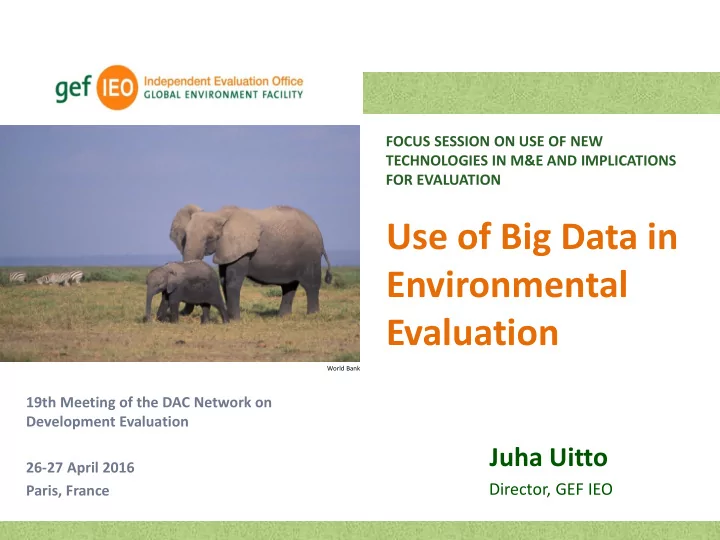

FOCUS SESSION ON USE OF NEW TECHNOLOGIES IN M&E AND IMPLICATIONS FOR EVALUATION Use of Big Data in Environmental Evaluation World Bank 19th Meeting of the DAC Network on Development Evaluation Juha Uitto 26-27 April 2016 Director, GEF IEO Paris, France
WHAT WE WILL TALK ABOUT What is big data? Why do we want big data in evaluation? What questions can we answer with big data? Challenges, limitations and lessons from using big data 2
What is BIG DATA? data sets that are so large or complex that traditional data processing applications are inadequate Characterized by o Volume from various sources needing large storage o Velocity at which they are generated o Variety of unstructured formats needing additional processing o Value or meaning not immediately apparent Adapted from Laney 2001, www.oracle.com and www.sas.com 3
Why use BIG DATA in evaluation? Scarcer financial resources o Need to target interventions where most needed Greater demand for transparency and country ownership o Need objective evidence base for decision-making o SDGs: 17 goals, 169 targets and 304 proposed indicators 4
SDGs and Earth Observation European Space Agency Big data such as from satellite imagery and sensor networks make environment and development indicators increasingly measurable
What can BIG DATA tell us? Where are the funds going? Is funding going to the right places? What change occurred over time? Did the intervention cause the change? What other factors might have led to the outcome? 6
Geographical context of interventions Where are the funds going? Visualization of geographical context 1292 GEF-supported protected areas ~2.8 million km 2 in 137 countries
Is funding going to the right places? Overlay of project sites with scientific criteria Use of global datasets + GIS analysis to determine overlaps of GEF support with critical sites
PA – 25km(excluding the inner) Percent Forest Cover (2000) PA – 10km PA Percent Forest Cover (%) Annual Percent Forest Loss (2000-2012) 1 PA PA-10km PA-25km 0.9 0.8 Percent Forest Loss (%) 0.7 0.6 0.5 0.4 0.3 0.2 0.1 0 1 2 3 4 5 6 7 8 9 10 11 12 Year What change occurred over time? Analysis of forest cover change Extraction of satellite data for 30,000 GEF and non-GEF sites 30-m resolution (LANDSAT) for 12-year period
Planetary level cloud computing with Google Earth Engine 10 years desktop computing = 7 days cloud computing
Did the intervention cause the change? Quasi-experimental analysis Propensity score matching found appropriate counterfactuals among 35,351 pixels using 9 socioeconomic and biophysical variables
GIS Model Satellite data Real World Data from field visits Problem-Driven Data from e-devices To assess Socio-economic conditions • Impacts • Causes • Trends Infrastructure Physical environment Location and boundaries What other factors might have led to the outcome? Machine learning and modelling Data-hungry algorithms required multiple global datasets of contextual variables in different formats to assess correlations with changes
Analysis of high-resolution images 2.5 m 30 m zoomed in to 2.5 m Images at 2.5 to 0.5 m resolution used to identify drivers of change that hinder success of GEF support NASA Digitalglobe NextView
Challenges and Limitations High computing power and technical skills needed Uneven availability and accuracy of contextual variables o often vary widely across countries and sites Cannot answer “how” and “why” questions Data only as good as available resolution o still need to do field verification/ groundtruthing Still need to account for possible biases in data collection methods 14
Solutions and Lessons Partner with global institutions with access to and infrastructure for using big data Used mixed approaches and methods o complemented global analyses with case study and portfolio analyses to triangulate findings Continue exploring use of new technology o drones, deep learning, internet of things, social media analysis, etc. Approach evaluation as a dynamic learning process o new data sets, approaches, issues will always emerge! 15
GEF Independent Evaluation Office with partners • Global Land Cover Facility, University of Maryland • WCPA-SSC Joint Task Force on Biodiversity and Protected Areas at IUCN • National Aeronautics and Space Administration (NASA) • AidData Page 16
Recommend
More recommend